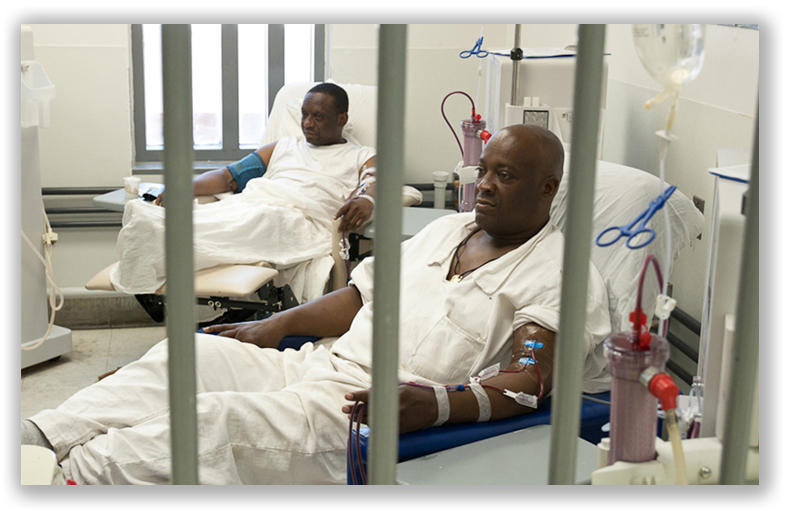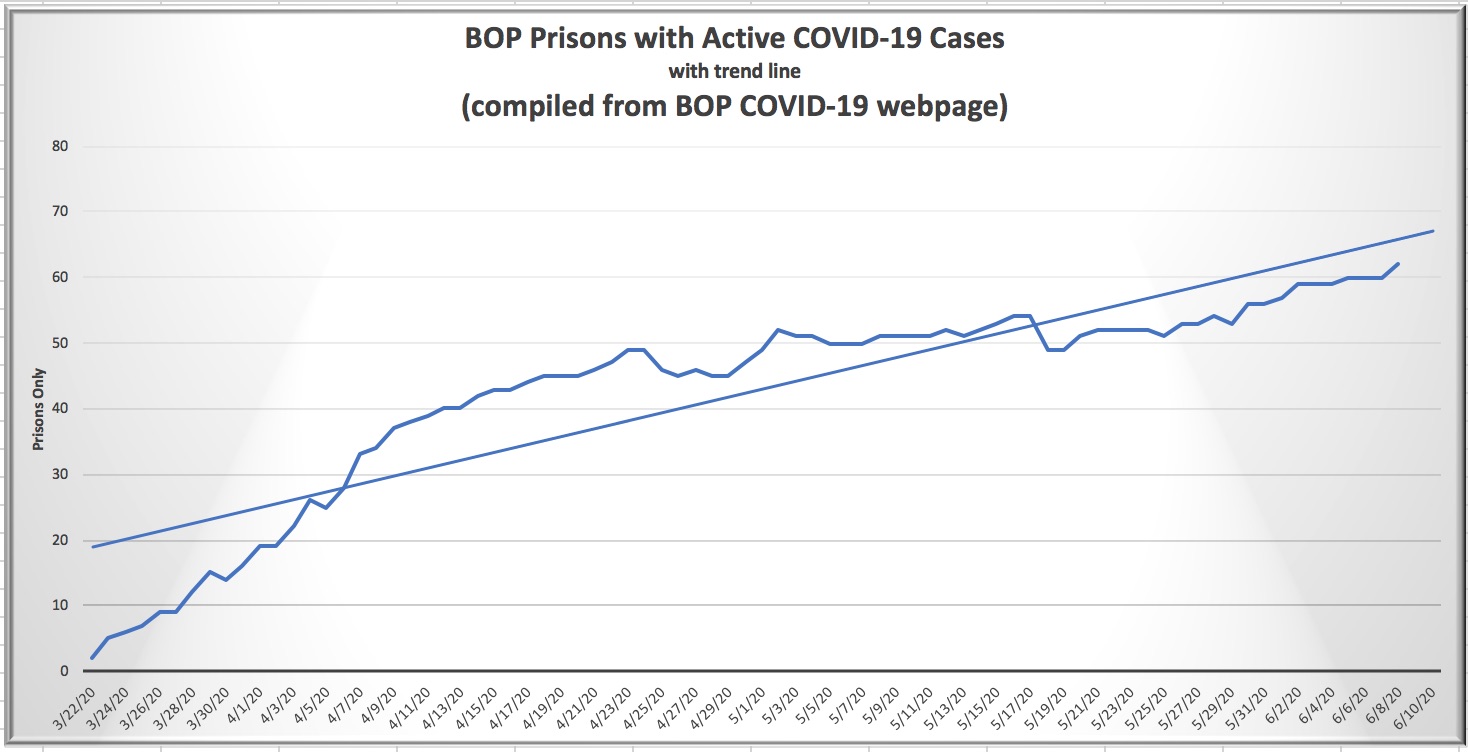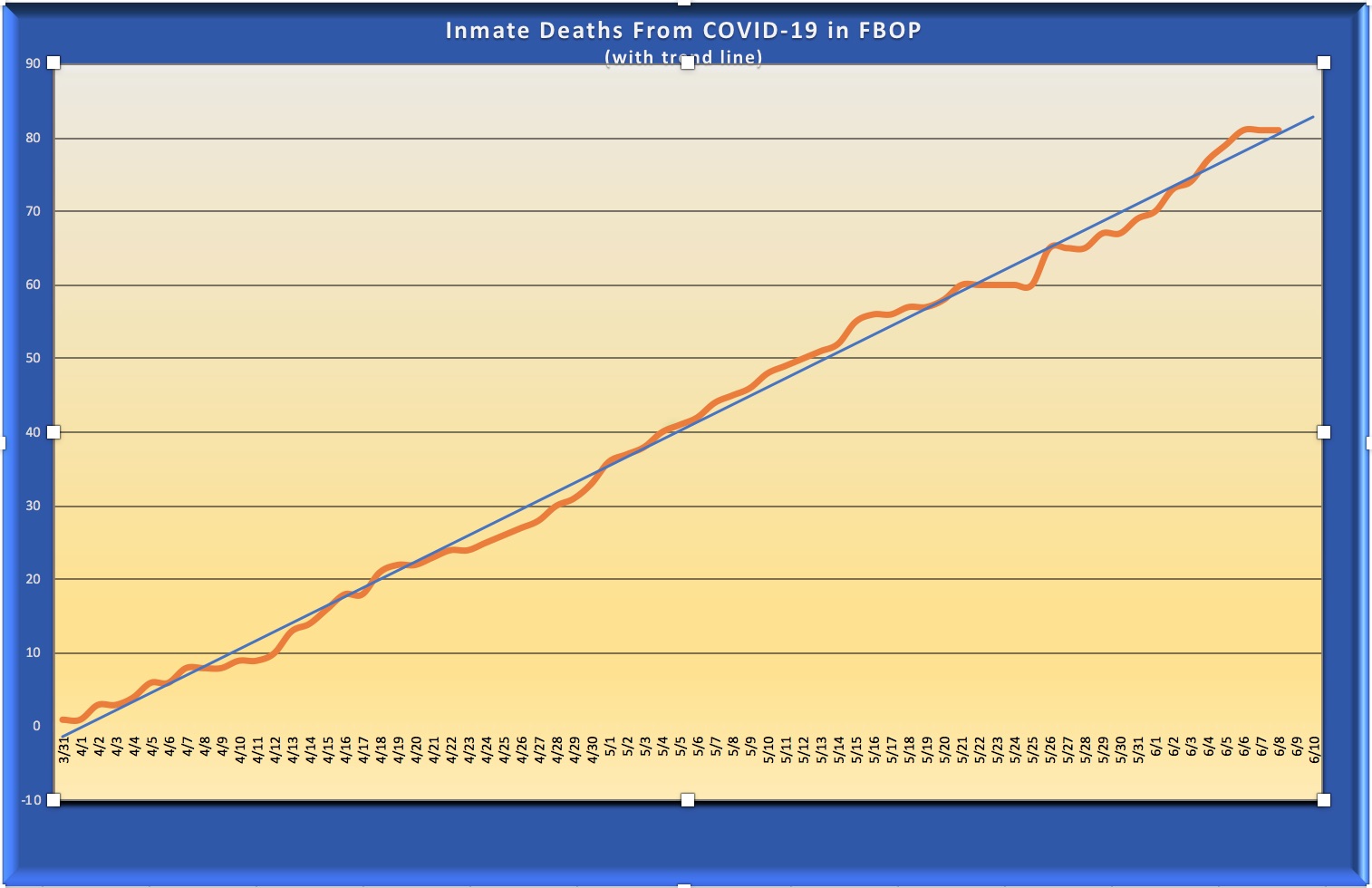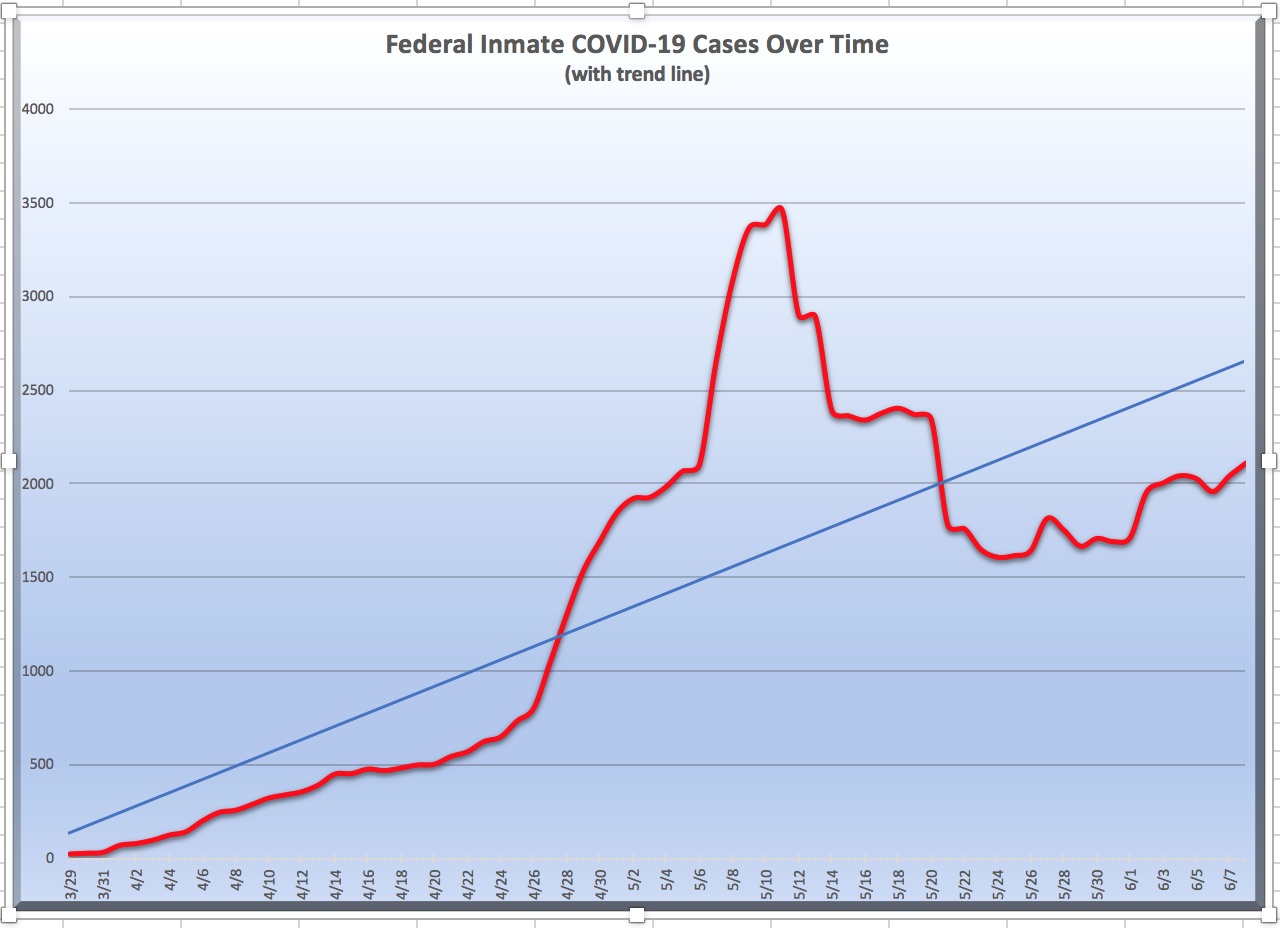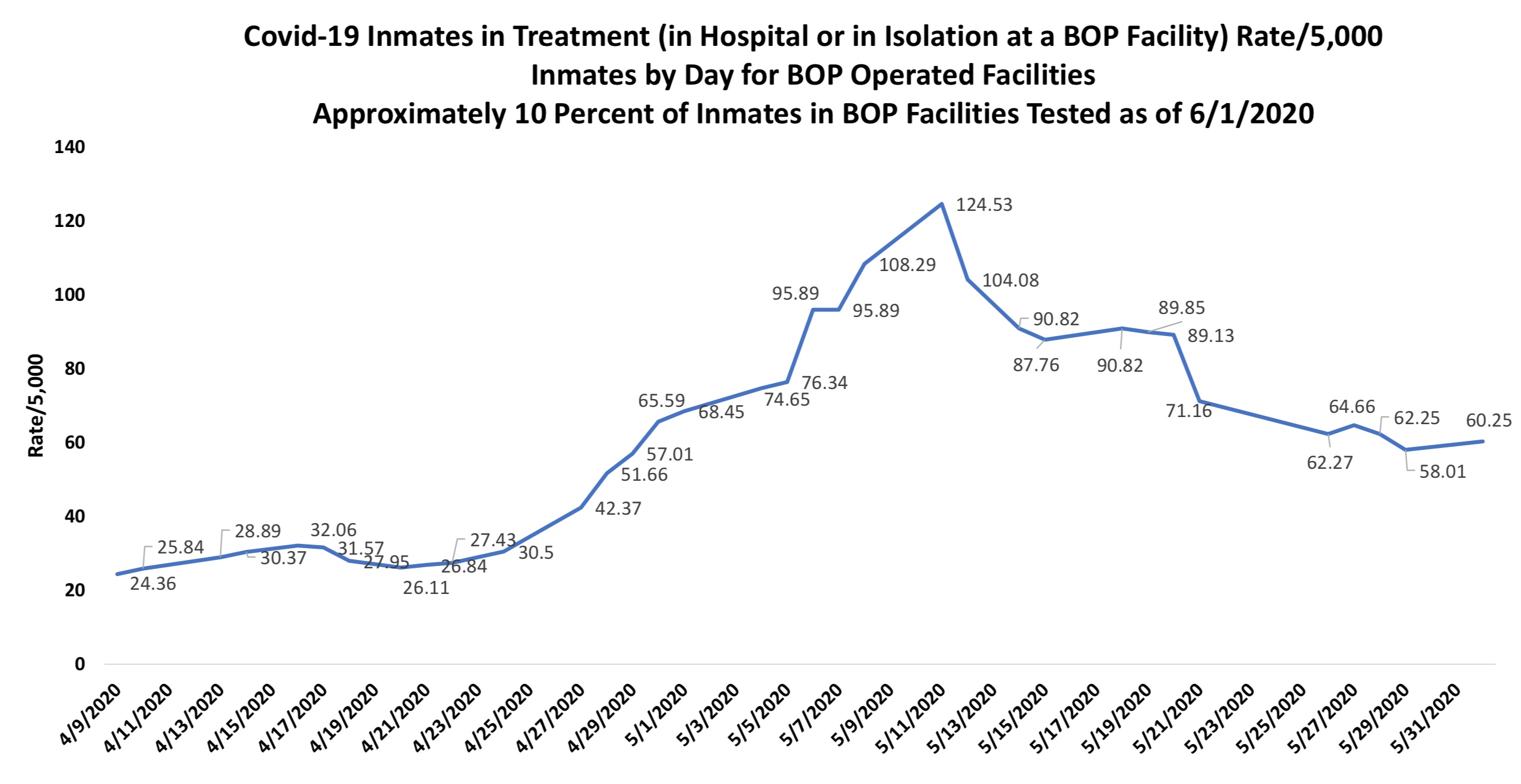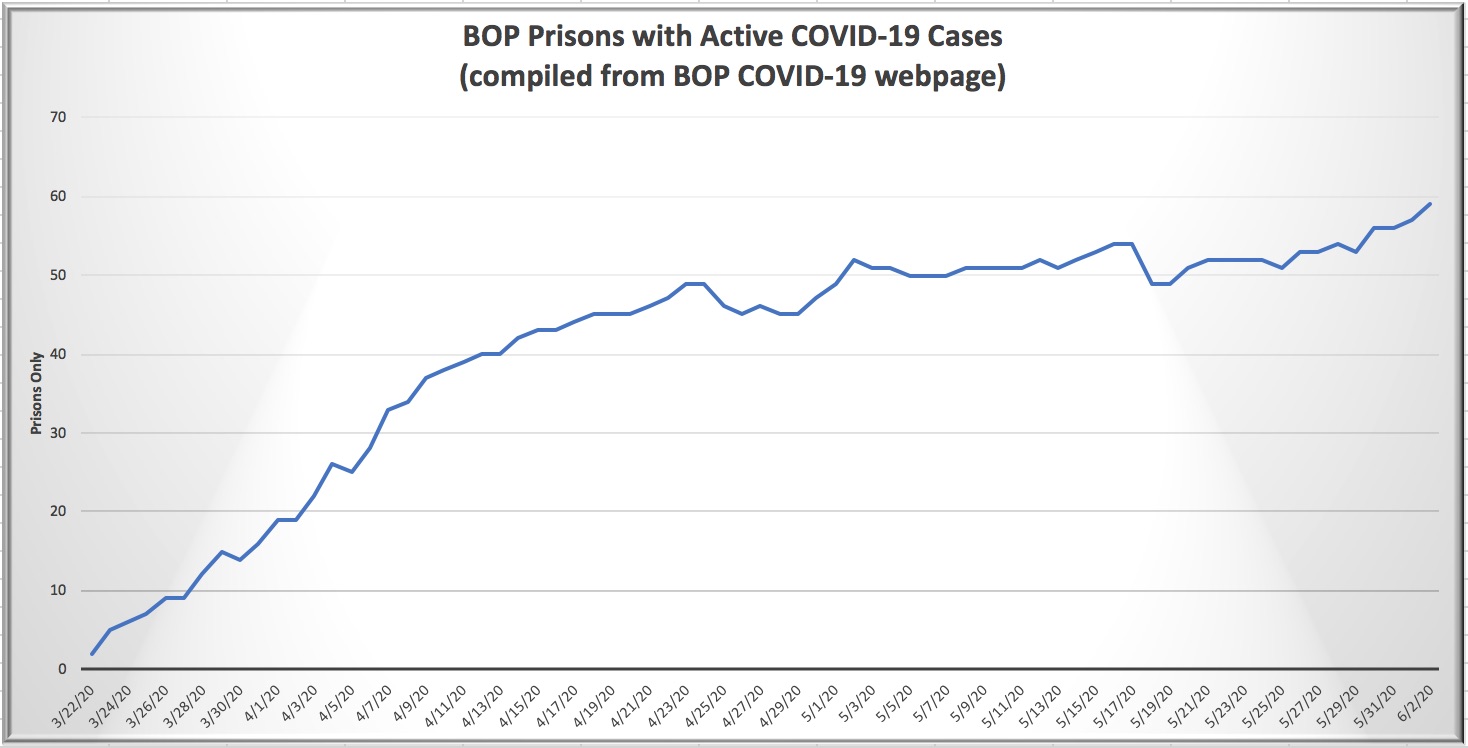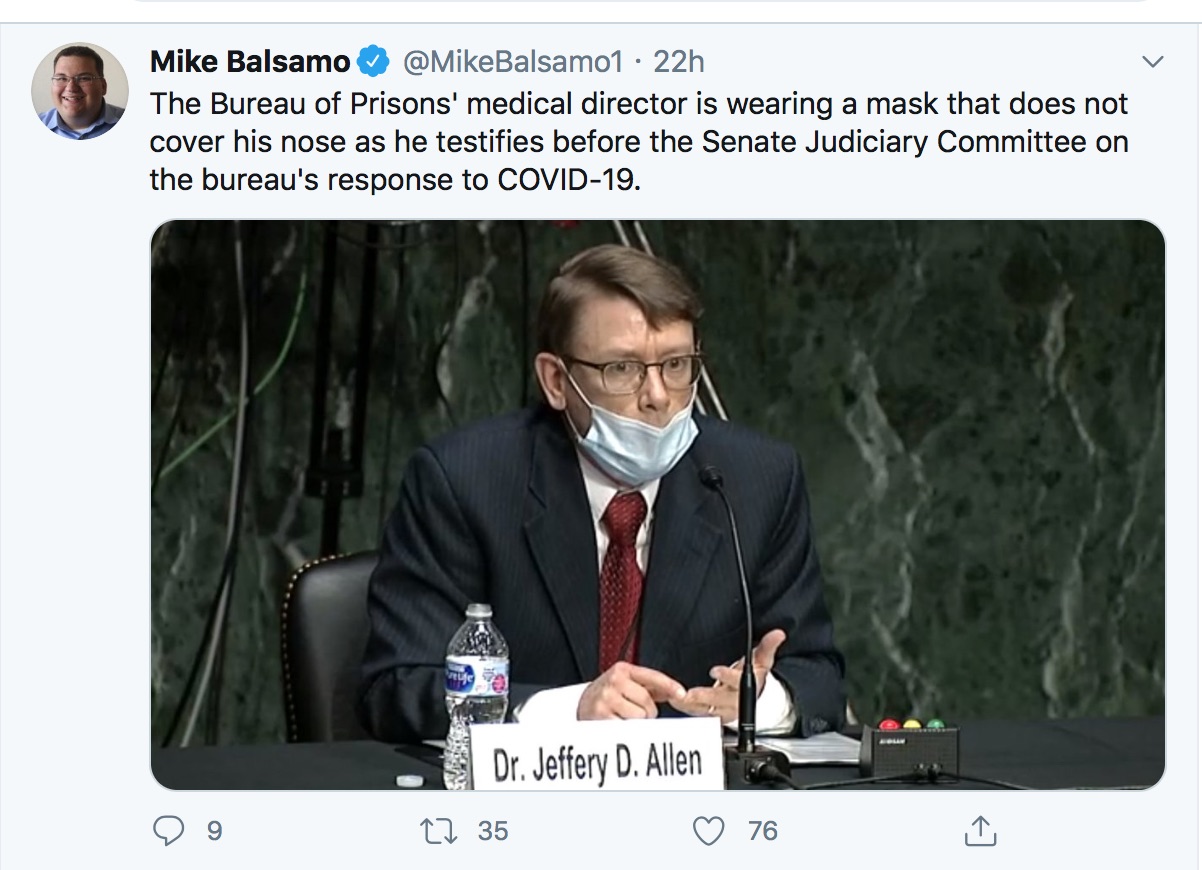We post news and comment on federal criminal justice issues, focused primarily on trial and post-conviction matters, legislative initiatives, and sentencing issues.

EVERYTHING’S UNDER CONTROL, BUT THE COUNT CLIMBS…
 The Bureau of Prison’s toll of inmates infected with coronavirus continued its meteoric climb last week, increasing 71% from 1,926 last Sunday night to 3,385 as of 5 p.m. yesterday. Six weeks into the BOP’s execution of its guidance memos, pandemic plans for preparedness, daily briefings and “comprehensive management approach for oversight of the situation,” inmates are dying of COVID-19 at a rate of better than one a day. The death toll today stands at 48.
The Bureau of Prison’s toll of inmates infected with coronavirus continued its meteoric climb last week, increasing 71% from 1,926 last Sunday night to 3,385 as of 5 p.m. yesterday. Six weeks into the BOP’s execution of its guidance memos, pandemic plans for preparedness, daily briefings and “comprehensive management approach for oversight of the situation,” inmates are dying of COVID-19 at a rate of better than one a day. The death toll today stands at 48.
At the Lompoc, California, facilities, the number of inmates with COVID-19 shot up to 842 this week, making it the largest federal prison outbreak. Lompoc surpassed FCI Terminal Island, California, in the nation, where 693 inmates have contracted the virus.
Nearly 70% of the FCI Lompoc inmates tested thus far have been positive, a number that exploded by more than 300 in recent days, officials said Friday. FCI Lompoc and Terminal Island now account for about 47% of all the federal inmates who have tested positive nationwide. Both prisons have done widespread testing of hundreds of inmates even without symptoms.
At a neighboring Lompoc medium-security prison on the same grounds, 31 inmates and 14 staff have become infected, officials said. Two Lompoc Medium inmates have died after contracting the virus.
Santa Barbara County Supervisor Gregg Hart on Friday expressed dismay with the BOP’s cooperation with the County. “We have been consistently rebuffed by prison authorities,” he said. FCI Lompoc accounted for 310 of the 311 new coronavirus cases in Santa Barbara County last Friday.
Senator Kamala Harris (D-California) telephoned the Terminal Island warden last week to demand to know how the virus rampaged through that facility. KCAL-TV, Los Angeles, reported that Harris told Warden Felicia Ponce she thought the institution was unprepared for the outbreak and that the warden should be pushing to release low-security inmates to home confinement. KCAL said Harris convinced the warden to agree to allow inmates to place phone calls, something that hasn’t been allowed since the outbreak began.
Meanwhile, the BOP announced that a 20-bed temporary hospital care unit has been built in a vacant Lompoc factory. The facility, planning for which started April 10, opened last Wednesday.
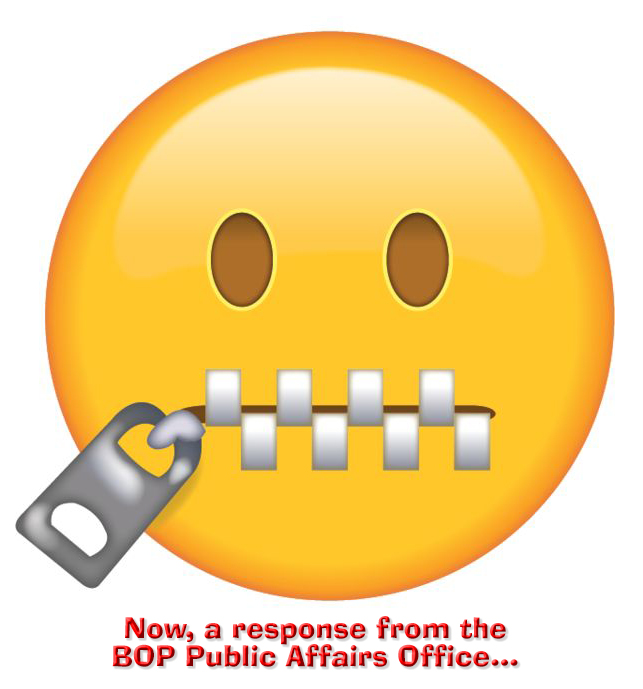 The BOP reported 619 active cases at FMC Fort Worth as of yesterday, “but they won’t share how many total cases they’ve had or how many of the 1,472 inmates are being tested,” according to WFAA-TV, Dallas. The prison recently added outdoor tents with room to separate 123 inmates, but the TV station said “it’s unclear if they’re using it.”
The BOP reported 619 active cases at FMC Fort Worth as of yesterday, “but they won’t share how many total cases they’ve had or how many of the 1,472 inmates are being tested,” according to WFAA-TV, Dallas. The prison recently added outdoor tents with room to separate 123 inmates, but the TV station said “it’s unclear if they’re using it.”
Last Wednesday, the BOP announced in plans to “substantially expand testing starting at BOP detention and quarantine sites,” using test instruments obtained from the US Dept of Health and Human Services. Three quarantine sites already have one machine each, which can do four tests an hour: FCI Gilmer, West Virginia; FTC Oklahoma City; and FCC Yazoo, Mississippi.
The Bureau said its testing protocols include that (1) inmates who have a negative test result and are asymptomatic will be placed in quarantine for a 14-day period; (2) inmates who have a positive test result but are asymptomatic, will be placed in isolation; (3) inmates who are symptomatic are placed in isolation prior to testing and will be immediately tested; and (4) inmates who have a Negative test result but are symptomatic will be placed in isolation.
On the litigation front, the judge in the ACLU case against FMC Devens last Friday denied the inmate plaintiffs a preliminary injunction ordering the release of inmates. The judge ruled that the plaintiffs had not shown the would succeed on the merits, because “both the BOP and FMC Devens have made significant changes in operations in response to COVID-19.” The judge wrote, “These affirmative steps may or may not be the best possible response to the threat of COVID-19 within the institution, but they undermine an argument that the respondents have been actionably deliberately indifferent to the health risks of inmates.”
But during a sentencing last Tuesday, a Southern District of New York federal judge blasted Attorney General William Barr’s failure to improve conditions at BOP facilities around the country. In giving a bank fraud defendant time served for the 15 months he had spent in jail awaiting trial, the Judge called MDC Brooklyn’s failures during the coronavirus crisis “very serious” but “not surprising,” noting that
to my knowledge, there have been no forthcoming serious reviews of the living conditions at either the MCC or the MDC, which are only many times compounded by this coronavirus that is plaguing the country, but in particular, the country’s prisons. It is an outrage, I have to say, and I’m very disappointed that the Attorney General has not followed through on making a thorough investigation of conditions that those of us in the business, as it were, are all too familiar with, and more importantly, has not implemented appropriate changes.
Last Friday, the wardens of those prisons told the Eastern District of New York that they had tested only 24 inmates in the last six weeks, out of over 2,400 in the two facilities. Eleven of those tests were positive.
 The inmate plaintiffs in the FCI Elkton case asked Norther District of Ohio Judge Gwin to enforce his prior order that the facility transfer or release the 837 vulnerable inmates identified in the Warden’s filing two weeks ago. Complaining that Elkton had released none of the identified inmates, the plaintiffs wrote, “of the 837 known subclass members – a number that is known to be underinclusive – Respondents have approved six people, or 0.7% of the subclass, for some form of release. That is equal to the number that had already been approved for home confinement transfers before Respondents answered the Petition in this case. Respondents have not, in other words, stepped up their pace in response to this Court’s Order.”
The inmate plaintiffs in the FCI Elkton case asked Norther District of Ohio Judge Gwin to enforce his prior order that the facility transfer or release the 837 vulnerable inmates identified in the Warden’s filing two weeks ago. Complaining that Elkton had released none of the identified inmates, the plaintiffs wrote, “of the 837 known subclass members – a number that is known to be underinclusive – Respondents have approved six people, or 0.7% of the subclass, for some form of release. That is equal to the number that had already been approved for home confinement transfers before Respondents answered the Petition in this case. Respondents have not, in other words, stepped up their pace in response to this Court’s Order.”
“Instead,” the plaintiffs argued, “they appear to be applying a set of unattainable filtering criteria. The reasoning for each rejection remains known only to Respondents, as they refuse to answer discovery about the conditional class. Across multiple cases, the BOP has taken contradictory and shifting views on what criteria apply for home confinement, for example.”
In the FCI Danbury case, the inmate petitioners are awaiting a Connecticut federal judge’s decision on their preliminary injunction demand. Meanwhile, the New Jersey ACLU has sued FCI Fort Dix, demanding release of medically vulnerable inmates to limit the prison’s population, and asking that the prison adopt the Centers for Disease Control guidance “regarding testing, medical isolation, quarantine, and social distancing for those who remain, to ensure constitutionally-compliant custody.”
If the prison does not do that ACLU-NJ Legal Director Jeanne LoCicero said in a statement, “FCI Fort Dix is speeding toward a public health catastrophe.” The BOP reported yesterday that 31 FCI Ft. Dix inmates have COVID-19.
Los Angeles Times, 70% of inmates test positive for coronavirus at Lompoc federal prison (May 9)
San Jose Mercury-News, 3 California prison inmates die from COVID-19 complications (May 7)
KCAL-TV, Families Push For Inmates At Terminal Island To Be Released Due To COVID Outbreak (May 8)
BOP, Hospital Care Unit at FCC Lompoc (May 4)
BOP, Bureau of Prisons To Expand Rapid Testing Capabilities (May 7)
Grinis v. Spaulding, Case No. 20cv10738 (D.Mass)
New York Daily News, Judge on Jeffrey Epstein case rips AG William Barr, saying his failure to fix Bureau of Prisons is ‘an outrage’ (May 6)
Wilson v. Williams, Case No. 4:20cv794 (N.D.Ohio)
Martinez-Brooks v. Easter, Case No. 3:20cv569 (D.Conn.)
Chunn v. Edge, Case No. 1:20cv1590 (E.D.N.Y.)
Letter to Judge Mauskopf in response to Adm Order 2020-14 (May 7)
NJ.com, N.J. federal prison is becoming a ‘deathtrap,’ ACLU says, seeking release of vulnerable inmates (May 4)
– Thomas L. Root


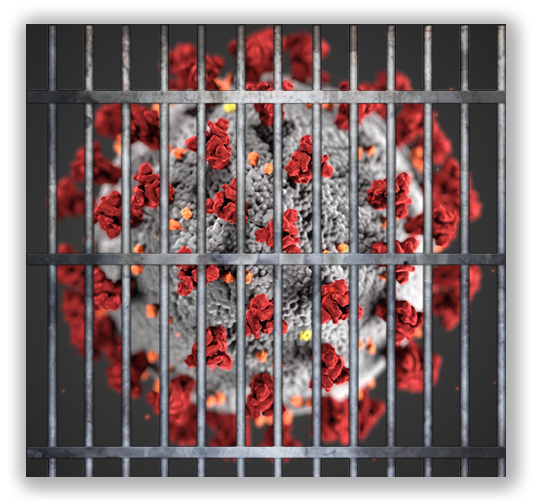 The New York Times reported last week that “cases of the coronavirus in prisons and jails across the United States have soared in recent weeks, even as the overall daily infection rate in the nation has remained relatively flat.” Certainly, the BOP’s own numbers suggest that little progress has been made in combatting COVID-19 in the BOP, and the stats contain an ominous sign.
The New York Times reported last week that “cases of the coronavirus in prisons and jails across the United States have soared in recent weeks, even as the overall daily infection rate in the nation has remained relatively flat.” Certainly, the BOP’s own numbers suggest that little progress has been made in combatting COVID-19 in the BOP, and the stats contain an ominous sign. The report said BOP Director Michael Carvajal refused an interview request, but a BOP spokesperson – while declining to comment on some of the allegations – maintained the agency’s response to the pandemic “was carefully planned and coordinated, and that it took an array of precautions to contain the outbreak.”
The report said BOP Director Michael Carvajal refused an interview request, but a BOP spokesperson – while declining to comment on some of the allegations – maintained the agency’s response to the pandemic “was carefully planned and coordinated, and that it took an array of precautions to contain the outbreak.”


